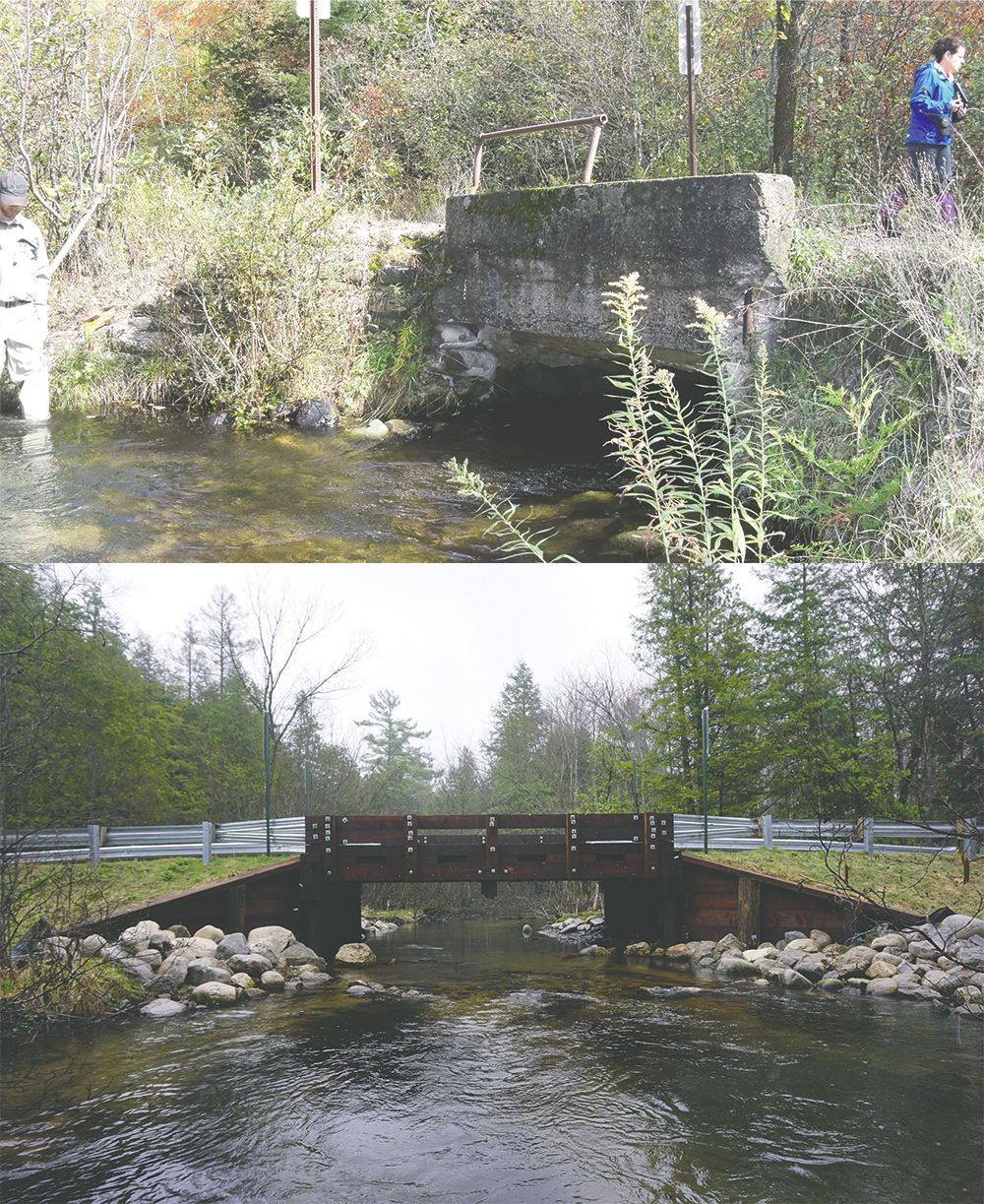Protecting bridges and saving fish on the Betsie
By Jacob Wheeler
Current Editor
Avid Benzie County fishermen may not know it, but the work of the Traverse City-based Conservation Resource Alliance (CRA) is integral to protecting cold-water-loving species such as steelhead, trout, and salmon in our streams.
The CRA was established in 1968 to preserve and protect Northern Michigan’s waterways, wildlife, and forests. The alliance currently protects 16 watersheds in 13 counties, from Beaver Island to the Pere Marquette and Manistee rivers. Here in Benzie, CRA focuses on the Betsie and Platte rivers, both important spawning grounds in the spring and the fall.
The Conservation Resource Alliance—together with partners that include the Benzie County Road Commission and some grant-giving organizations—have built timber bridges across three points on the Upper Betsie, one of the coldest tributaries to the Betsie River. In July, they will replace yet another road crossing, this time on Red Creek, a tributary to the Betsie, near Thompsonville.
Reinforcing these aging and ailing bridges opens up the river channel and lets the stream—and the fish—flow more naturally beneath them.

One place that has been redone is at the intersection of Nessen and Bentley roads, rustic two-tracks to the northeast of Thompsonville where the Upper Betsie makes a bucolic meander through rural Benzie County before feeding the main Betsie River, which eventually dumps into Frankfort and Elberta’s Betsie Bay and Lake Michigan.
This stretch suffers from warm water temperatures during the high summer months, according to Kim Balky, a project manager and biologist with the CRA. Yet fishermen rely on the health of these tributaries, because the Little Betsie and Deer Creek are cold-water havens for trout and great nurseries for steelhead and salmon.
“Because the previous structure was so undersized here, high-water events—from snowmelt to storm events—would get funneled through the old structure, create more white water, and create a large pool,” Balky says. “Increased water velocity is tough for fish in the early stages of their life, especially when they have to fight the current and get upstream.”
But now, the Nessen-Bently intersection flows freely, thanks to the CRA stepping in. Balky says that the CRA first identifies significant environmental concerns in each watershed that the organization works in. Then the CRA gathers appropriate partners together to determine solutions and to raise funds to implement those solutions.
Two years ago, the CRA worked with the Benzie County Road Commission to replace a century-old bridge here that was originally made with concrete and timber. The project—which Balky dubbed “a glorified Lego kit” —cost approximately $150,000 and received matching state funds. According to Balky, the structure was deteriorating, cement was fracturing, and the bags of concrete that had been left by volunteers more than 20 years ago had done little to prevent the eventual crumbling of this road crossing. The river was only eight feet wide and constricted, causing pool formations downstream.
“We raised grant dollars to build a timber bridge that helped open the river channel,” Balky says. “The Little Betsie is a state-designated natural river. So not only is the bridge structurally sound now, it’s aesthetically pleasing, because it ties in with the natural feeling of the area. And it allows water and fish to move more freely.”
The Nessen-Bentley bridge is one of 100 road crossings over the Betsie and its tributaries, Balky estimates. If each of those crossings is undersized, structurally compromised, or bleeds sand from the roadbed into the stream, that is 100 different sites of impact. Balky stresses the need to replace bridges while they are still functioning, because CRA’s grant sources do not operate in emergency mode.
Furthermore, climate change threatens more extreme weather events, such as heavy rain or severe storms that will cause high-water events.
“With climate change, you can’t just fix one site, you have to look at all of them,” Balky says. “You need to make sure that if the stream can get through here, it can also get through downriver as well.”
Jacob Wheeler is a contributor to NatureChange.org, a new online magazine that covers conservation and climate change in Northern Michigan. CRA is among a host of environmental nonprofits that sponsors Nature Change. Watch Nature Change’s interview with Balky and a video story about the Upper Betsie at NatureChange.org. And look for more Nature Change stories that impact Benzie County in The Betsie Current this summer. Learn more about the CRA at RiverCare.org.




